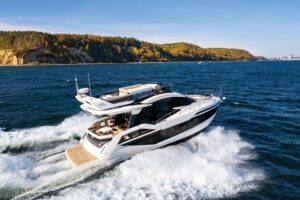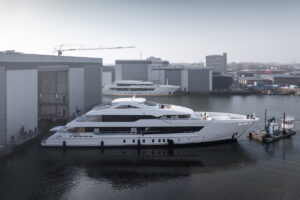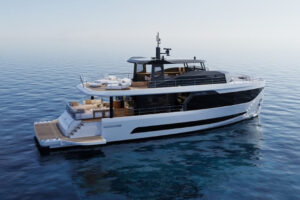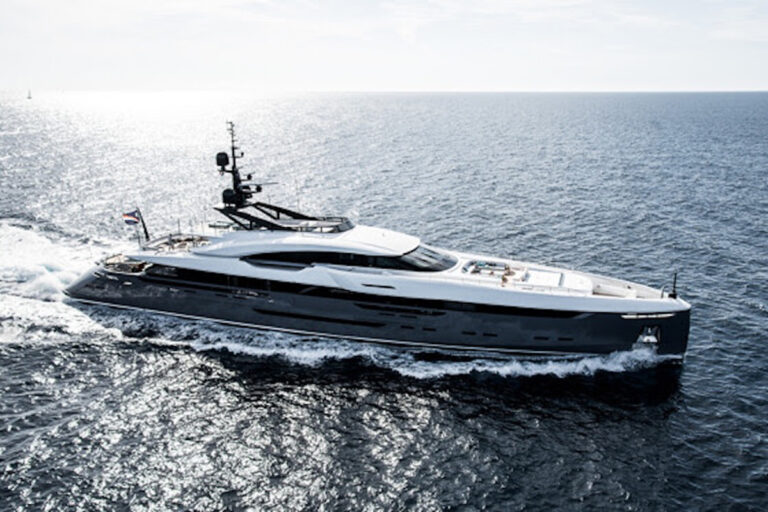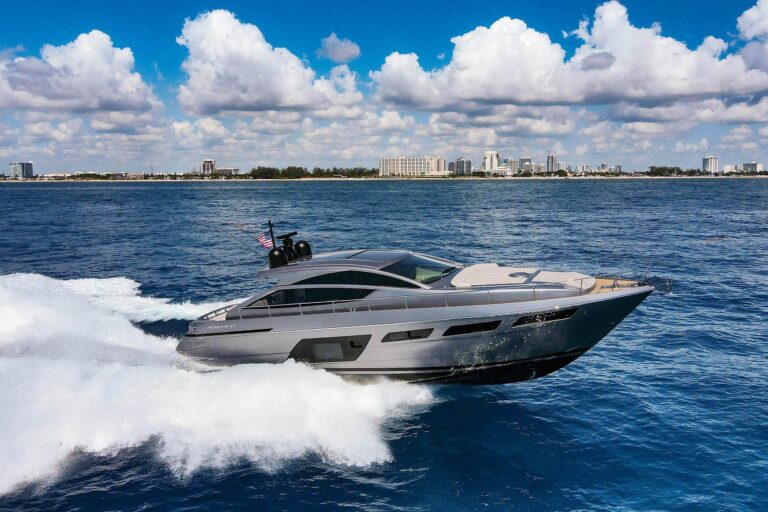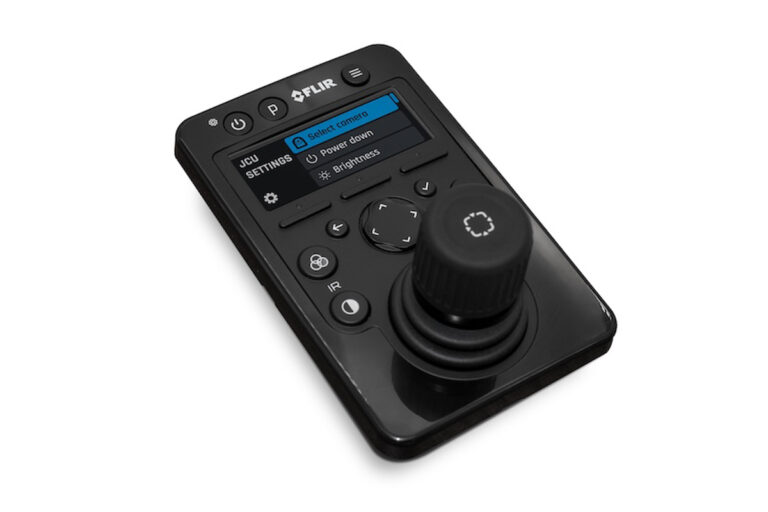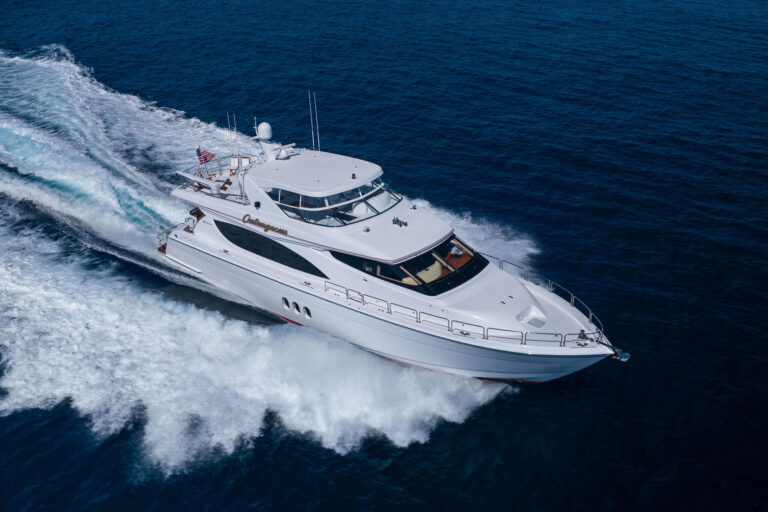Boat companies spend good money creating, tweaking and reinforcing their images, and Bertram Yacht, as part of the glamorous Ferretti Group, is no stranger to sophisticated marketing strategies. They are also, however, the recipient of the kind of dock chatter that complements and even outdoes any Madison Avenue efforts. Just ask anyone with a passion for powerboats; they will tell you what Bertram has always been about: the ride.
Recently, I had the opportunity to spend a couple of days with two very special boats that allowed me the opportunity to relive a bit of the company’s past and gain a sense of its future-a vintage 31 Bertram and a new 57 Bertram fitted with Anti-Rolling Gyros (ARGs). Bertram Yacht exists because of the 31—a single design that revolutionized offshore powerboat racing and changed the way yachtsmen used their boats. It still gives me chills to think that the 31 Bertram would not have come to be if not for a racing sailor’s chance encounter with an odd boat. It was a breezy July morning in 1958 off Newport, Rhode Island-perfect weather for the scheduled America’s Cup trials. Dick Bertram and the sailors in his charge on the 12-meter Vim were distracted from their duties by a 23-foot powerboat slicing though the 6-foot seas at speeds that would have splintered the designs typical of the day. They took a second look.
The little boat was in fact the prototype of a new design by C. Raymond Hunt that was serving as tender to the 12-meter Easterner-also designed by Hunt. Though his formal education ended at prep school, Hunt was thoroughly at home at sea and approached a wide variety of design challenges with practical experience and a flair for the unconventional. It is really quite amazing that at about the same time he penned what would become known as the Deep-V, he also doodled the soon-to-be 13-foot Boston Whaler on an envelope. Those are arguably two of the most influential and successful designs in a generation.
Dick Bertram recognized this genius and took time off from his yacht brokerage business to build a 31-foot version of Hunt’s new Deep-V design. Christened Moppie (Bertram’s wife’s nickname), the boat was conceived as a utility but plans soon changed when the boat’s ability caught the attention of Bertram’s racing buddies. After Moppie won the 1960 Miami-Nassau race, setting a new record in the worst conditions of the event’s history, the future of the Deep-V was secured. At the time, Bertram is said to have commented “so many yachtsmen were waving their checkbooks at him” that he had no choice but to build boats.
ertram Yachts was launched in 1960 in Miami with a 31, not unlike the 1969 model I enjoyed spending time aboard thanks to her owner, Jon Burkard, vice president of the Allied Richard Bertram Marine Group. While this boat sold new for about $22,000, like so many 31s it has been lovingly restored and is worth many times that amount today. While others had fiddled with high-deadrise designs, Hunt perfected the form. The 31’s incredible ability in heavy seas changed the float plans of a generation of yachtsmen. Bertram salesmen would routinely demonstrate her by running in big seas-at times, with no hands on the wheel. Aboard a 31, fishing days that were marginal in terms of weather were comfortable, and days that were out of the question were doable.
Over the years I have spent many hours on 31s and there is no other boat quite like her. With 22 degrees of deadrise, the 31 levels head seas and tracks down sea as though she were on rails. She is not perfect: Those steep sections consume horsepower. (Twin big-block gas engines suit her, as do modern lightweight diesels.) She can be surprisingly wet when the seas kick up, which is why add-on spray rails are popular. At rest in a beam sea, she is tender compared to boats with less deadrise. Still, she’s as capable and safe a boat in heavy seas as you will find-and she is a thrill to command and a pleasure to look at.
With the 31’s success, Bertram’s product line quickly expanded, as did the length overall of its models. By the late 1970s, new designs on the drawing board exceeded 50 feet and Bertram’s design team knew that they had reached the practical limits of the true Deep-V form. High deadrise angles (above 20 degrees) were great for taming seas but the after sections of larger boats tended to stay in the water and lift was far more important-particularly given the horsepower available and the speed requirements at the time. It was at this juncture that Bertram’s engineer, Lee Dana, and designer, Dave Napier, crafted a 54-foot design that would earn the same respect the 31 had garnered two decades earlier.
Introduced in 1981, the 54 had deep forward sections, a shallow keel and a more efficient 17-degree deadrise at the transom. This form blended perfectly with her stout 75,000-pound displacement and many (including yours truly) considered the 54 one of the best “sea boats” ever designed. Like the 31 she seemed oblivious to head seas, yet she was dry. She was also far stiffer at rest than earlier, deeper deadrise Bertram designs and with a reasonable amount of power (800 hp, Detroit Diesel 12V71s) she could cruise at around 24 knots. She seemed her best in nasty seas and such conditions are still referred to by fans of the marque as “Bertram Weather.”
Sales of the 54 helped keep Bertram’s production line moving during difficult years in the 1990s and when the Ferretti Group acquired the company in 1998, the 54’s design was as valuable an asset as the brand. Ferretti wisely left the hull as it was and recast the design’s styling and interior. After all, like the 31, it was the 54’s comfort and performance at sea that attracted fishing and cruising owners.
The 57 is created out of the 54’s DNA, which made good sense, as adding a bit of length to a planning hull without adding significant weight often benefits performance. The 57 we ran for this story was fresh from the factory with a pair of 1,650 hp Caterpillar C32s. She is capable of a maximum speed of 39 knots with a full tower and fishing gear.
The 57 is indeed an impressive boat on face value and this was the reason Bertram chose her as a test platform for the ARG system-a technology they believe may revolutionize comfort at sea. When Norberto Ferretti learned of Mitsubishi’s ARG system he installed it on his personal yacht-a 30-meter Ferretti Custom Line Navetta. Given the success of this application, José Millan, Bertram’s product development manager, knew it was only a matter of time before the system would find its way onto a Bertram. “No matter how good a hull is, slow trolling and live-bait fishing in rough seas can tire you or worse-fishboats seem an ideal application for the ARG technology,” said Millan.
Millan supervised the installation of two ARG MSM-2000s in the 57. Each of the 630-pound units consists of an electric motor driving a gimbaled flywheel contained neatly in a 36.7 x 23.3 x 21.3 inch housing that is bolted securely to the main stringers and positioned aft of the engines in the machinery space. Unlike active fin stabilizers, nothing protrudes from the hull, so, other than the added weight and a 6 kW thirst for power, there is no performance penalty. A remote panel on the flybridge has an on/off switch and two indicator lights that monitor system status. According to Millan, Mitsubishi technicians insist that no maintenance is required, “simply switch it on and switch it off.”
We did just that for a day of fishing and while we chose to switch the system on dockside there is no problem doing so at sea if desired. From start-up, the flywheel takes 30 minutes to reach operational speed (4400 rpm) and 45 minutes to come to a stop when it is turned off. I frankly did not notice the whirling noise the ARGs made until we shut the engines down offshore for a bit of snapper fishing. The sound is not loud or objectionable but it is noticeable. I am pleased to report that it did not seem to bother the snapper-we caught our share.
While the seas were not particularly challenging, we lay beam-to for a time to note the system’s effect. While subtle, I found the response to the 4-foot seas tangible. From still in the water, it seemed to take one roll cycle to inspire a reaction from the ARGs. After that, the amplitude of the roll was noticeably reduced. Millan indicated that this sensation increases with wave height, particularly in light-ship conditions. Mitsubishi’s data on the 57 suggests a roll suppression rate of 44 percent at rest in a beam sea and 52 percent at trolling speed.
While the ARG is an impressive technology and one that has been applied successfully on commercial vessels, it will most likely take a particularly sea-sensitive yachtsman or mate to invest, as it will be an expensive option on the 57. With that said, in terms of comfort, ARG(s) can make a great boat better. Given the contrast of the 31 and the 57 it occurs to me that it is Bertram that deserves the credit-for this has been their mission from the start.
Contact: Bertram Yacht, (305) 633-8011; www.bertram.com.

